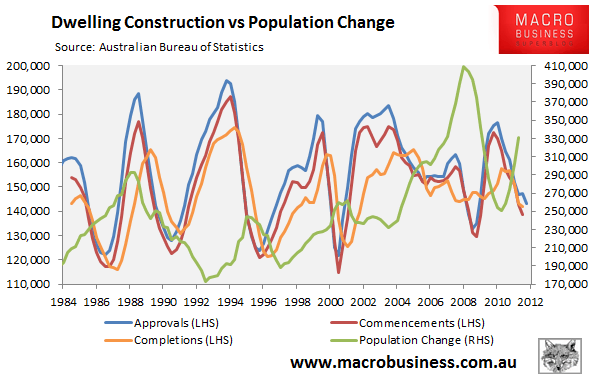
Recent weakness in housing construction, along with rising population growth, suggests that the supply situation facing the Australian housing market is about to worsen once more.
The situation is highlighted by the below chart, which plots the rolling annual change in population against dwelling approvals, commencements, and completions:

Population growth accelerated over the past five quarters, from 255,000 people in the year to December 2010 to 330,000 in the year to March 2012 – an increase of 75,000 people per annum.
By comparison, between December 2010 and June 2012, annual dwelling commencements (completions) fell by -31,000 (-9,400) dwellings.
As noted previously, overall housing construction in Australia is running at levels below the 28-year average, despite Australia’s population having grown by around 40% over that period. Australia also experienced no pick-up in housing construction after house prices surged between 1996 and 2010, suggesting that housing supply in Australia has become increasingly inelastic (unresponsive).
As the mining investment boom winds down, the Reserve Bank is hoping that dwelling construction will increase to fill the void. While lower interest rates and new home incentives introduced in New South Wales, Queensland and South Australia, should help to stimulate new home sales and construction, they do not fix the core of the problem: artificially inflated fringe land values brought about by more than a decade of urban consolidation policies implemented across Australia. These policies have acted to reduce the available supply of land across Australia, encouraged land banking, and forced-up the cost of new housing.
Until Australia’s restrictive urban planning systems are reformed, and housing-related infrastructure is adequately funded to accommodate Australia’s growing population, the supply situation is unlikely to be resolved in any meaningful way.
Twitter: Leith van Onselen. Leith is the Chief Economist of Macro Investor, Australia’s independent investment newsletter covering trades, stocks, property and yield. Click for a free 21 day trial.

